2006 Egypt
3 January 2007, Wednesday; Yassien Hotel,
Aswan, LE30
We began our day with a koshary breakfast
just near our hotel. Tasty, filling and cheap (LE6.5 for two). And served by a
woman (unusual) in a spotlessly clean (unusual), well-run place.
Then cycled through the souq, through
familiar territory, on our erratic bikes (hard work with off-road tyres, wonky
wheels, jerky pedals, etc). The souq road soon ended in a narrow dirt road
through which we walked pushing our bikes. Some tourists still, but not so
obviously touristy (ie unpaved, narrow road and more goods for locals on
offer). Perfume bottles, Nubian basketry, pharaonic bits ’n bobs, cotton
scarves.
Then down and up and round to the Nubian
Museum. By which time we were heartily tired of the bikes and ready, therefore,
to consider an offer by a taxi driver opposite the entrance for a trip to the
new dam and Philae.
We spent about 2.5 hours in the excellent
Nubian Museum – which takes visitors on a Nubian journey from about 8000BC
through modern day Nubia. Via their stint as Egyptian pharaohs. Well-stocked;
well laid-out; well-signed. As always, the museum left me feeling ignorant.
After some slightly unpleasant negotiations
with our taxi driver (an agricultural engineer with a wife, two sons and a
daughter, and no work in the summer; who drives someone else’s car for a
living, cannot afford his own and cannot think of a summer job / income) we
headed across the old dam wall for the third time – the first two times being
en route to and returning from Abu Simbel. With the First Cataract and Aswan to
our right / north and Aswan Dam and Philae Temple to our left / south. The
Aswan Dam was built by the British to regulate the flow of the Nile and
therefore bring more land under cultivation between 1898 and 1902. It was the
largest of its kind in the world at that time, measuring 2,441m across and
being constructed from local granite. It was raised twice, between 1907-12 and
1929-34.
It was totally eclipsed by the construction
of the High Dam 6km upstream between 1960 and 1971. This was construction on a
massive scale – using 18 times the material needed for Khufu’s Great Pyramid
and creating, at 5,250km2, the world’s largest artificial lake, Lake Nasser.
We crossed the High Dam wall to look at the
turbines and the waters of both dams. Quite impressive. An earth wall,
electricity generation, a filter to keep silt and crocs to the south (“big
crocodiles” said our driver).
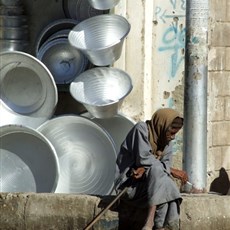
Souq
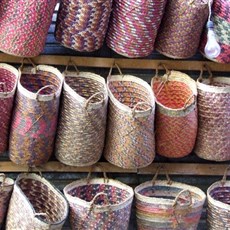
Souq
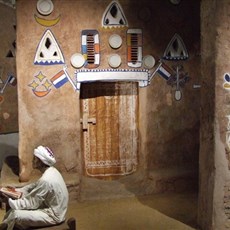
Nubian Museum
Back then and round to the docks on the east bank of Aswan Dam for the 20 minute boat ride out to Philae Temple where we strolled for 40 minutes or so at our last Pharaonic monument (except for our proposed camel ride around Giza when we get back to Cairo). A pretty temple in a pretty setting – despite being defaced first by the Christians and then the Muslims.
Philae Temple facts
The island temple at Philae was constructed over a three-century period by the Greek Ptolemaic dynasty and the Roman Principate.
The principal deity of the temple complex was Isis, but other temples and shrines were dedicated to her son Horus and the goddess Hathor.
In Ptolemaic times Hathor was associated with Isis, who was in turn associated with the Greek goddess Aphrodite.
For centuries the temple complex was the holiest site for Isis worshippers.
It was officially closed down in the 6th century AD by the Byzantine emperor Justinian.
It was the last pagan temple to exist in the Mediterranean world.
The Philae temple was converted into a church dedicated to the Virgin Mary until that was closed by Muslim invaders in the 7th century.
In 1902, the Aswan Low Dam was completed on the Nile River by the British.
This threatened many ancient landmarks, including the temple complex of Philae, with being submerged.
The dam was heightened twice and the island of Philae was nearly always flooded.
By 1960, UNESCO had decided to move many of the endangered sites along to Nile to safer ground. Philae’s temple complex was moved, piece by piece, to Agilkai, 550 meters away, where it was reassembled and remains today.
That project lasted from 1977 to 1980.
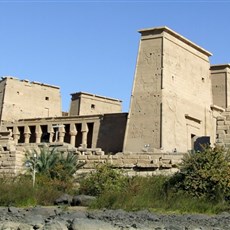
Philae temple
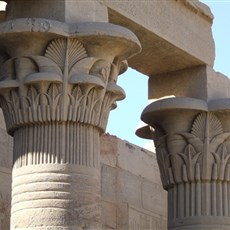
Philae temple
And finally to the quarry containing the unfinished obelisk. This was ordered by Seti I from a granite quarry and would have weighed over 1,000 tonnes and been 41m high. What an amazing sight / site. Reddish granite which supplied stone for monuments and sarcophagi and statues to the north. Cut by chipping a series of holes in the rock, inserting a wooden wedge, wetting the wedge, causing it to expand and the rock to crack. It is impossible to imagine how the ancient Egyptians planned to move their gigantic obelisk, but there it lies – testament to their belief in their ability to do so.
Back on our bikes and along the corniche – via a camera shop where Charl transferred his photos from his memory stick to a CD – to return our bikes. A different man was at the bike shop and was reluctant to settle for our agreed LE50 total for the 1.5 days of our hire (he wanted double). Luckily one of our original guys appeared on the scene, said “agreement”, and the money was exchanged without unpleasantness.
To tea on the corner where a passing man commented that we had found somewhere “quiet” to drink. Luckily he added “no hassle” – meaning we were away from the tourist drag – as we were confused due to the noise of the traffic and TV assaulting our ears. Home for a nap and out for a dinner of stuffed pigeon and fried fish at Medina Restaurant in the souq. We have become familiar faces in the souq and are seldom requested any more to purchase things, just greeted with cries of Bafana Bafana.
Then a stroll to the Nile and to buy biscuits and so to bed.
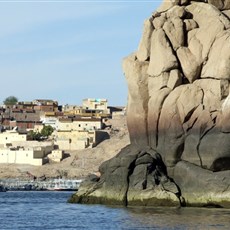
Nile

Unfinished obelisk